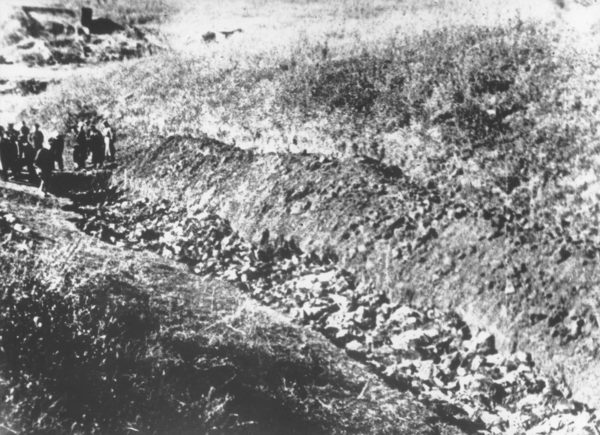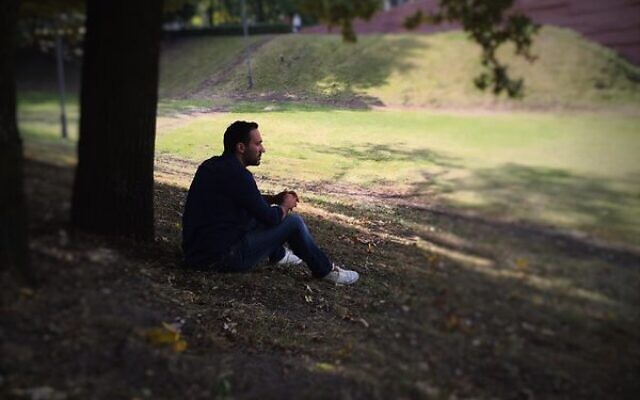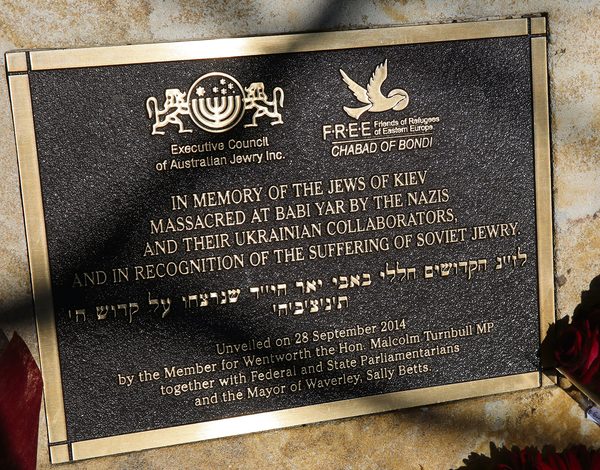‘It is the duty of every Jew to know their story’
Over the course of just two days, on September 29-30, 1941, more than 33,000 Ukrainian Jews were shot to death at Babi Yar. Eighty years on, Alex Ryvchin discusses his personal connection to the massacre and his reflections on its anniversary.
You visited Babi Yar in 2016. Why did you want to go?
In truth, I was haunted by that place. My family’s home was literally a block from it and I would often think that had my grandparents not fled the city a few weeks before the SS entered it, they would have ended up in that ravine and I would never have been born. The more I read about the history of that place, the more I struggled to grasp how that massacre could occur. How the Nazis could simply enter the city, place posters throughout summoning the Jews to assemble at Babi Yar and 33,771 Jews were then stripped, dispossessed and shot to death. Their lives terminated for no reason. And the locals, for the most part, relished it, lined the streets to watch the wretched parade of Jews walking to their deaths. They looted them, betrayed them to the Germans and actively participated in the killing process. So I felt I owed it to the dead to go there, to perform my own march of the living, to descend into the ravine, and try to imagine the terror that they felt.
What were your impressions when you went there?
I left with no better understanding of that place than when I arrived. Some things are beyond our poor powers of comprehension. There is no explanation for why that massacre occurred. How people could act so brutally to their fellow man. It left me only with a sense that there is a streak of human nature that wants to destroy things and inflict misery on others. We have been on the receiving end of that more than any other people because of our uniqueness, our vulnerability, our statelessness. Going to Babi Yar made me more aware that antisemitism is a disease without a cure and that only through Jewish strength and self-reliance can we protect ourselves from it.

What do you think Babi Yar symbolises?
In terms of the Holocaust, Babi Yar emerged as the symbol of the extermination of some 1.5 million Jews in forest pits, ravines and parks throughout the former Soviet Union. Every town, city and village in those lands has its own killing field, its own Babi Yar. What is particularly interesting about the way in which the Jews were killed in Kiev and other sites in the Soviet Union is the gradual process of dehumanisation that occurred elsewhere in Europe – the classification of Jews, their removal from public life, their confinement to ghettoes as precursors to their extermination – did not occur in the Soviet Union. The SS could simply enter, summon the Jews or identify them with the help of the locals and shoot them immediately. It shows how the people of the Soviet Union had been primed into supporting the annihilation of their Jewish neighbours over centuries.
Why is so little known about Babi Yar as opposed to other sites of Holocaust atrocities?
What happened to the Jews of the Soviet Union was a largely ignored aspect of the Holocaust. Firstly, the manner of execution left no camps or crematoria that serve to educate and remind. Secondly, the Einsatzgruppen were so efficient in their work that in most places there were no survivors left to tell the story. Thirdly, the Soviet Union officially denied that the genocide of the Jews on their territory had occurred with the wilful collaboration of Soviet citizens as this undermined the myth of Soviet unity in the face of fascist invaders. This meant that for many years after the Holocaust there were no memorials, no education centres, no discussion about what had happened. To this day, many of the killing fields are abandoned, desecrated or forgotten.
What can and should be done to rectify that?
It is the duty of every Jew to know their story. I don’t merely mean that Jews of Soviet extraction should know what happened to their ancestors and appreciate how fortunate they are to have even been born. Every Jew should have a complete understanding of the Holocaust. What happened at Belzec and in Budapest is as much a part of my story and identity as what happened a block from my home in Kiev, the city of my birth. I would like to see a better understanding in our community that nearly half of our six million martyrs were murdered outside the six death camps and that the perpetrators of the Holocaust were not only soldiers of the German SS, but ordinary people from across Europe. This is a confronting reality, but one we have to understand.
What has the Australian Jewish community done to ensure the memory is not forgotten?
In 2014, a monument was erected in Waverley Park in Bondi to the victims of the Babi Yar massacre and to the Soviet victims of the Holocaust. This was unveiled by former prime minister Malcolm Turnbull. It is only the second monument to Babi Yar erected outside Kiev. In 2017, a landmark performance of Shostakovich’s Symphony No 13, subtitled Babi Yar, was held in Melbourne in front of 2000 people. I was honoured to deliver a keynote speech at that event to educate on what happened at Babi Yar. And earlier this year the NSW Jewish Board of Deputies made the destruction of the Soviet Jews the subject of their annual Yom Hadhoah event. We are blessed to have scholars such as Konrad Kwiet in our community and devoted individuals such as George and Margaret Foster and George Deutsch who have done invaluable work to ensure the story of Soviet Jewry during the Holocaust is told.
Alex Ryvchin is the co-CEO of the Executive Council of Australian Jewry.



comments